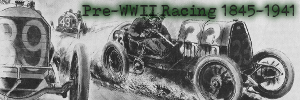















Here and There in Motoring's Past: 1910 - Brighton Beach Motordrome, Fiat vs Simplex |
|---|
 Topics: Fiat, Simplex, Ralph DePalma, George Robertson
Topics: Fiat, Simplex, Ralph DePalma, George Robertson
|
Peter Helck
Antique Automobile
March-April 1972
Brighton's auto racing history began in 1903. By 1910 the old one-mile horse track just west of noisy Coney Island had become the most-used oval in the east for what the sports writers called "The Grinds." These were endurance contests for basically production cars, the earliest form of 24 Hour Racing. These "Motor Marathons" were usually preceded by a matinee, a card of shorter races comprising a variety of categories, including that spectator's delight, the Free-for-All. In this class were invariably time trials and assaults on the one-mile record by such worthies as DePalma's Fiat "Cyclone," Walter Christie's front-drive monsters, the Blitzen Benz's of Oldfield and "Wild Bob" Burman.
Among the most publicized matinee programs was the "added attraction" of a series of match races between two idols of the metropolitan race-going crowds. These were Ralph DePalma with his veteran 60 "Cyclone" and George Robertson with the new Simplex-90 track special. A toss of the coin gave DePalma the pole. At the crack of the starter's pistol, the Italo-American quickest off the mark, and it was not until the fourth mile that the Simplex passed the "Cyclone" and finished the five miles as winner, on a flat tire. The second heat at two miles also went to Robertson.
Though this match seemed conclusive, sufficient clamor arose for a return bout a few weeks later. This time the principals, their managers and the officials were in lengthy conclave. Towering above this group, Robertson won the toss-up for pole position. As the Fiat and Simplex were lined up, their engines spitting fire, Fiat's emissary, Josephs, rushed over to the impatient driver at the pole. DePalma had changed his mind about the agreed-upon rolling start. "Listen," roared "G.R.," "tell your man it's all the same to me, standing, rolling, or flying start. I'll lick him just like the last time!" This he did, in two straight heats.
The passing of 34 years did little in diminishing the Robertson gusto. In 1944 I had finished the first of eight motoring paintings for Esquire. The subject was, "ROBERTSON COMES THROUGH." It showed "G.R." winning the 1908 Vanderbilt on No. 16 Locomobile. Popular writer, Paul Gallico, had been commissioned to do the commentary for this feature. Esquire thought it useful for Gallico, at that time a sports specialist, to meet Robertson personally.
All those involved met at the Hotel Roosevelt. As "G.R." had retired from racing late in 1910, it was immediately obvious that his achievements were not known by Gallico. As if to properly place the ex-driver in perspective, and not without a hint of reportorial insolence, he asked the big fellow, "Did you ever race against Barney Oldfield?" "Oldfield," barked "G.R.", "you're damned right I did, and I licked him every time we met."
